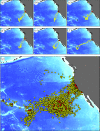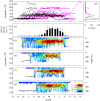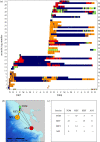Philopatry and migration of Pacific white sharks
- PMID: 19889703
- PMCID: PMC2842735
- DOI: 10.1098/rspb.2009.1155
Philopatry and migration of Pacific white sharks
Abstract
Advances in electronic tagging and genetic research are making it possible to discern population structure for pelagic marine predators once thought to be panmictic. However, reconciling migration patterns and gene flow to define the resolution of discrete population management units remains a major challenge, and a vital conservation priority for threatened species such as oceanic sharks. Many such species have been flagged for international protection, yet effective population assessments and management actions are hindered by lack of knowledge about the geographical extent and size of distinct populations. Combining satellite tagging, passive acoustic monitoring and genetics, we reveal how eastern Pacific white sharks (Carcharodon carcharias) adhere to a highly predictable migratory cycle. Individuals persistently return to the same network of coastal hotspots following distant oceanic migrations and comprise a population genetically distinct from previously identified phylogenetic clades. We hypothesize that this strong homing behaviour has maintained the separation of a northeastern Pacific population following a historical introduction from Australia/New Zealand migrants during the Late Pleistocene. Concordance between contemporary movement and genetic divergence based on mitochondrial DNA demonstrates a demographically independent management unit not previously recognized. This population's fidelity to discrete and predictable locations offers clear population assessment, monitoring and management options.
Figures






References
-
- Anderson S., Pyle P.2003A temporal, sex-specific occurrence pattern among white sharks at the South Farallon Islands, California. Calif. Fish Game 89, 96–101
-
- Baker J. D., Polovina J. J., Howell E. A.2007Effect of variable oceanic productivity on the survival of an upper trophic predator, the Hawaiian monk seal Monachus schauinslandi. Mar. Ecol. Prog. Ser. 346, 277 (doi:10.3354/meps06968) - DOI
-
- Baum J., Myers R., Kehler D., Worm B., Harley S., Doherty P.2003Collapse and conservation of shark populations in the Northwest Atlantic. Science 299, 389–392 (doi:10.1126/science.1079777) - DOI - PubMed
-
- Bonfil R., Meyer M., Scholl M., Johnson R., O'Brien S., Oosthuizen H., Swanson S., Kotze D., Paterson M.2005Transoceanic migration, spatial dynamics, and population linkages of white sharks. Science 310, 100–103 (doi:10.1126/science.1114898) - DOI - PubMed
-
- Boustany A. M., Davis S., Pyle P., Anderson S., Le Boeuf B., Block B.2002Expanded niche for white sharks. Nature 415, 35–36 (doi:10.1038/415035b) - DOI - PubMed
Publication types
MeSH terms
Substances
LinkOut - more resources
Full Text Sources

